2. 北京大学地球与空间科学学院, 北京 100871;
3. 南方海洋科学与工程广东省实验室(广州), 广州 511458;
4. 中国地质科学院地质力学研究所, 自然资源部古地磁与古构造重建重点实验室, 北京 100081;
5. 中国地质科学院探矿工艺研究所, 成都 611734;
6. 成都理工大学, 成都 610059
2. School of Earth and Space Sciences, Peking University, Beijing 100871, China;
3. Southern Marine Science and Engineering Guangdong Laboratory(Guangzhou), Guangzhou 511458, China;
4. MNR Key Laboratory of Paleomagnetism and Tectonics Reconstruction, Institute of Geomechanics, Chinese Academy of Geological Sciences, Beijing 100081, China;
5. Institute Exploration of Technology, Chinese Academy of Geological Sciences, Chengdu 611734, China;
6. Chengdu University of Technology, Chengdu 610059, China
2008年5月12日,青藏高原东缘龙门山断裂带发生了Ms 8.0级地震,这次地震造成龙门山映秀-北川和灌县-安县断裂带同时破裂,分别产生240~270km和~80km长的地表破裂带(付碧宏等,2008a;李海兵等,2008;李勇等,2008;刘静等,2008;徐锡伟等,2008),并且破裂带具有不同运动学性质:沿映秀-北川断裂带产生的地表破裂具有斜向逆冲运动性质,其中南西段(映秀断裂带)以由北西向南东逆冲为主伴随右旋走滑性质,北东段(北川断裂带)以右旋走滑为主伴随逆冲性质,而沿灌县-安县断裂带的地表破裂为纯逆冲性质(付碧宏等,2008a;李海兵等,2008;李勇等,2008;刘静等,2008;徐锡伟等,2008; 李传友等,2008)。汶川地震余震分布显示,余震群分布呈北东-南西走向,南西段余震分布宽度大且主要集中在破裂带西北侧,北东段余震分布宽度较窄,主要在破裂带两侧(Zhang et al., 2010)。震后通过InSAR研究发现,映秀-北川断裂带深部滑动面的几何形态在西南段向北西方向缓倾,在北东段变为近直立陡倾(Shen et al., 2009)。因此,汶川地震沿映秀-北川断裂带破裂过程中南西与北东两段具有不同的破裂行为。然而,造成同一破裂带南西与北东段不同的破裂行为的原因目前尚不清楚,其破裂机制和发震机理也不明了。断裂带的岩石组成和内部结构是了解断裂性质、破裂机制、力学状态和流体行为的关键(Faulkner et al., 2008;Wibberley et al., 2008),也是认识断裂带地震活动性和演化过程的重要因素(Chester et al., 1993;Scholz,2002)。因此,汶川地震后,许多学者通过地表露头和汶川地震断裂带科学钻探(WFSD)岩心对映秀-北川断裂带物质组成、内部结构、物理性质以及摩擦行为进行了多方位的研究(Li et al., 2013, 2014; Yao et al., 2013a, b;Wang et al., 2014a, b;Liu et al., 2016; Togo et al., 2011a, b,2016),并取得了一系列重要认识:在映秀-北川断裂带南西段(映秀断裂带)虹口地区,断裂带的宽度约240m,由碎裂岩、断层泥、断层角砾岩和多期次假玄武玻璃组成(Li et al., 2013;Wang et al., 2014a, 2015),表明映秀-北川断裂带是一条经常发生大地震的断裂带(Wang et al., 2019a)。然而,这些研究主要集中在映秀-北川断裂带南西段,对北东段(北川断裂带)则少有报导,仅在地表断层泥方面有少量研究(付碧宏等,2008b;韩亮等,2010;袁仁茂等,2013)。目前北川断裂带的物质组成和内部结构仍然不清楚,这制约着对汶川地震机制的全面认识,尤其是制约着对北川断裂带的地震滑移行为和地震活动性的认识。
本文以映秀-北川断裂带北东段(北川断裂带)南坝地区露头剖面为研究对象,通过野外观测以及样品采集、显微构造观察和地球化学分析等,来探讨北川断裂带的岩石组成和内部结构。虽然地表露头所获得的断裂带物质受到风化过程的影响,但是该研究仍然可以揭示断裂带的构造变形及其活动性,为认识龙门山断裂带地震破裂机制和断裂动力学提供科学依据。
1 构造背景与分析方法 1.1 构造背景龙门山断裂带地处青藏高原与四川盆地之间(图 1a),为中国东部和西部地形地貌的边界,也是我国重要的地震活动带之一(邓起东等,1994)。龙门山断裂带总体以北东向南西延绵,全长约500km,宽约30~50km,断裂带可分为北段、中段和南段(刘树根,1993)。该断裂带在新生代晚期沿中生代造山带重新活化(Burchfiel et al., 1995, 2008;Kirby et al., 2002, 2008)。
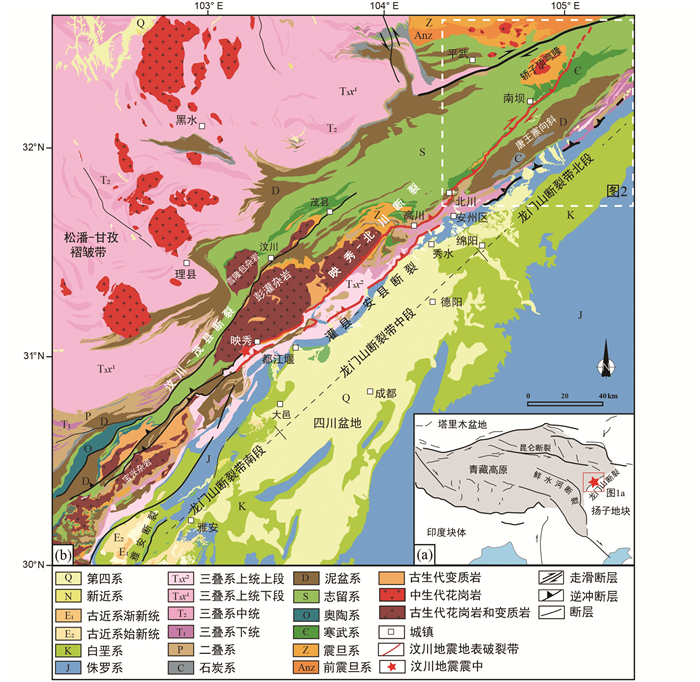
|
图 1 青藏高原及其邻区构造简图(a)和龙门山构造地质图(b,据四川省地质局,1967①, 1975②, 1977③修改) Fig. 1 Sketch tectonic map of the Tibetan Plateau and its adjacent areas (a) and geological map of the Longmen Shan fault belt (b) |
① 四川省地质局. 1967. 1/20万广元幅地质图
② 四川省地质局. 1975. 1/20万松潘幅地质图
③ 四川省地质局. 1977. 1/20万平武幅地质图
龙门山断裂带主要由三条近平行的逆冲断裂带组成(图 1b),由西向东分别为:汶川-茂县断裂(龙门山后山断裂)、映秀-北川断裂(龙门山中央断裂)和灌县-安县断裂(龙门山前山断裂)(Jia et al., 2006;李勇等,2006)。基于多种构造特征及演化历史,可将龙门山断裂带自北东向南西以高川-秀水一线和卧龙-怀远一线(都江堰以南)为界划分为三段,即龙门山断裂带北东段、中段和南西段(图 1b);龙门山断裂带北东段位于高川-秀水一线之北东的部分,以出露轿子顶基底杂岩和发育唐王寨向斜为典型特征;龙门山断裂带中段位于高川-秀水一线与卧龙-怀远一线之间的部分,以后山带出露彭灌杂岩和前山带发育飞来峰群为显著特征,同时这里也是汶川地震震中所在部位;龙门山断裂带南西段位于卧龙-怀远一线之南西的部分,以出露五龙、宝兴基底杂岩及其前缘发育飞来峰为典型特征(李智武等,2008;刘树根等,2008)。
映秀-北川断裂不仅是青藏高原东缘地形陡变带的边界(Kirby et al., 2008),控制着区域地貌的分布,而且是2008年汶川地震的发震断裂,沿断裂中段和北东段形成240~270km长地表破裂带(李海兵等, 2008;徐锡伟等, 2008)。
本文研究区位于四川省平武县南坝镇地区,属于映秀-北川断裂带北东段的北川断裂带。研究区内主要发育有震旦、寒武、志留及泥盆纪的砂板岩互层,且有少量碳质板岩(图 2)。其中震旦纪地层为千枚岩、结晶灰岩、变砂岩和硅质白云岩;寒武纪地层为变砂岩、板岩和硅质岩;志留纪地层为千枚岩夹变砂岩、灰岩;泥盆纪地层为石英砂岩、粉砂岩和泥岩。研究剖面位于寒武纪砂板岩中(图 2b),并出露2008年汶川地震地表破裂带(图 3),破裂带伴随有~2m的垂直位移和~2.8m的右旋水平位移(李海兵等,2008),破裂面发育在断裂岩中。

|
图 2 映秀-北川断裂带北东段构造地质图(a,据中国地质调查局发展研究中心,中国地质科学院,2008①;四川省地质调查院,2012②修改)及地质剖面(b) Fig. 2 Tectonic and geological map (a) and cross section (b) of the NE segment of the Yingxiu-Beichuan fault belt |
① 中国地质调查局发展研究中心,中国地质科学院. 2008. 1/25万汶川地震灾区地质构造图
② 四川省地质调查院. 2012. 1/5万平武县南坝镇汶川地震科学钻探四号孔(WFSD-4)施工区地形地质图

|
图 3 南坝地区汶川地震地表破裂带特征 (a)地表破裂带特征,可见水平位移和垂直位移;(b)地表破裂面,破裂面发育在黑色物质层上边界面 Fig. 3 The Wenchuan co-seismic surface rupture near Nanba (a) surface rupture with horizontal displacement and vertical displacement; (b) co-seismic slipping surface. The black material mainly occurred within the footwall |
沿着南坝地区出露的北川段断裂带剖面,我们对断裂岩及其围岩进行了系统采样。为确保取样的连续性和完整性,断裂两盘断层角砾岩带和破碎带取样间距约0.5~2m,黑色断裂物质中间隔2~5cm连续取样,共采集24块样品,其中20块样品进行了XRD测试(表 1),中间黑色断裂物质选取NB-1~5、断层角砾岩带样品NB-12和破碎带样品岩石NB-14制成薄片。
|
|
表 1 北川断裂带南坝露头断裂岩矿物含量 Table 1 Mineral contents of fault rocks in the Beichuan fault zone at Nanba outcrop |
首先将岩石薄片在光学显微镜下观察,然后对代表性样品薄片在扫描电镜下进行详细观测,包括矿物组成、颗粒大小、结构构造等特征,分析其微观构造与断裂流体作用。利用粉末样品进行X射线衍射(XRD)仪器分析其物质成分及结构等信息,通过微区X射线荧光分析仪(μXRF)对重要样品薄片开展化学成分面扫描,分析元素分布特征。SEM和μXRF实验在自然资源部深地动力学重点实验室进行,XRD实验在北京北达智汇微构分析测试中心进行。
2 南坝地区北川断裂带宏观构造在南坝镇北东方向~500m处的省级公路(S105)被2008年汶川地震错断,破裂面产状为走向N44°E,倾向NW,倾角70°,被错断的公路产生~2.8m的右旋水平位移和~2m的垂直位移(图 3),显示出右旋走滑伴随由NW向SE方向逆冲的运动学特征。震后公路重新修复,路边断裂带明显呈现。从地表露头剖面来看,断裂带宽度约为30m,总体走向为N40°~45°E,以发育黑色断裂物质层为中心,两侧发育断层角砾岩和破碎带(图 4)。汶川地震破裂面沿黑色断裂物质层上边界分布,断裂带上盘物质为断层角砾岩、破碎带和具弱破裂的围岩;断裂带下盘物质为黑色物质层、断层角砾岩、破碎带和具弱破裂的围岩(图 4),围岩主要为变质砂岩和板岩。

|
图 4 南坝地区北川断裂带野外露头及样品位置 (a)断裂带野外照片;(b)断裂带素描.红色线为汶川地震地表破裂带 Fig. 4 Field outcrop and sample locations in the Beichuan fault zone in Nanba area (a) photograph of the outcrop; (b) geological sketch of the fault zone. The red line is the surface co-seismic rupture of the Wenchuan earthquake |
断裂带上盘,与黑色物质层相邻的断层角砾岩层厚约4m,其北西侧破碎带厚度约10m。断裂带下盘,黑色物质层厚20~40cm,相邻断层角砾岩层厚约3m,其南东侧的破碎带厚度约12m,呈现出近对称的单核断裂结构。黑色物质层与断层角砾岩有明显的边界,其中北西边界平直,南东边界凹凸不平(图 4),破碎带与围岩之间没有明显的界限。黑色断裂物质和断层角砾岩均发育有弱面理(图 5a, d)。宏观上看,黑色断裂物质固结较好且粒度较细(图 5e),较脆易破碎,内部未见明显的角砾,可略见两组面理构造(图 5a, b)。在黑色物质层北西侧边界发育厚约10mm厚的狭窄的薄层(图 5b),从2008年汶川地震快速应急调查现场结果来看,地表破裂面发育在黑色物质层的上边界面(图 3),这狭窄的边界层是汶川地震的滑动带,贯穿整个黑色物质层北西边界,呈NW方向陡倾的面理。在黑色物质带中有一条厚约2~3cm的黄褐色条带(图 5c),它与旁边的黑色块体有较明显的边界(图 5c);另外,在黑色物质层中可见SW向陡倾的面理(图 5),与NW方向陡倾的汶川地震滑动带呈~30°夹角。

|
图 5 南坝地区北川断裂带断裂岩特征 (a)断裂带核部黑色物质层中可见面理(白色虚线);(b)断裂带核部露头,顶部(黑色物质层NW侧边界)为汶川地震滑动带(红色虚线);(c)中心黑色物质层的露头,标记有连续采样点(NB-1~10);(d)面理化的断层角砾岩;(e)黑色断裂物质手标本 Fig. 5 Fault rocks of the Beichuan fault zone in Nanba area (a) foliations occurred within the black material layers in the core of the fault zone (white dashed line); (b) outcrop of the core of the fault zone, the top (NW boundary of the black material layer) is the co-seismic slipping zone of the Wenchuan earthquake (red dashed line); (c) outcrop of the black material layer, showing continuous sampling locations (NB-1 to 10); (d) fault breccia are characterized by well-developed foliations; (e) specimen of the black material |
研究区中北川断裂带发育在寒武纪粉砂质板岩中,破碎带中岩石的显微构造基本与粉砂质板岩构造特征一致,断层角砾岩保留有围岩的部分构造特征,断裂带中黑色断裂物质几乎看不见围岩构造特征。
破碎带中的岩石原岩结构仍然保留(图 6a),只是微破裂增多。断层角砾岩主要由具有原岩特征的、大小不一的、角砾状碎块组成,碎块之间不规则接触, 无明显位移,断层角砾岩中次生面理构造明显(图 6b),面理产状与黑色断裂物质层近一致。

|
图 6 南坝地区断裂岩光学显微照片 (a)断裂岩岩石特征;(b)面理化的断层角砾岩 Fig. 6 Microstructural features of the fault rocks at Nanba (a) general characteristics of fault rocks; (b) foliated fault breccia |
黑色断裂物质在光学显微镜下主要呈黑色和棕灰色或灰褐色,呈块状和角砾状结构(图 7),其中黑色物质总体粒度均匀,薄片中可见规模不同的不规则次生裂隙,裂隙中有被黄棕色物质充填(图 7e)。黑色断裂物质层的西边界与角砾岩接触部位,可见变粉砂岩中汶川地震的滑动带,同时在黑色断裂物质边界有厚约0.5mm的滑动带(图 8a)。棕灰色物质基质较为均匀,可见不规则次生裂隙,其内部分布大小不一的黑色断裂物质碎块,碎块多为次棱角状到次圆状,可见浑圆块体(图 7、图 8),还可见砂岩砾(图 8b,c,e),棕黄色物质围绕角砾边缘分布(图 8c,d,f)。
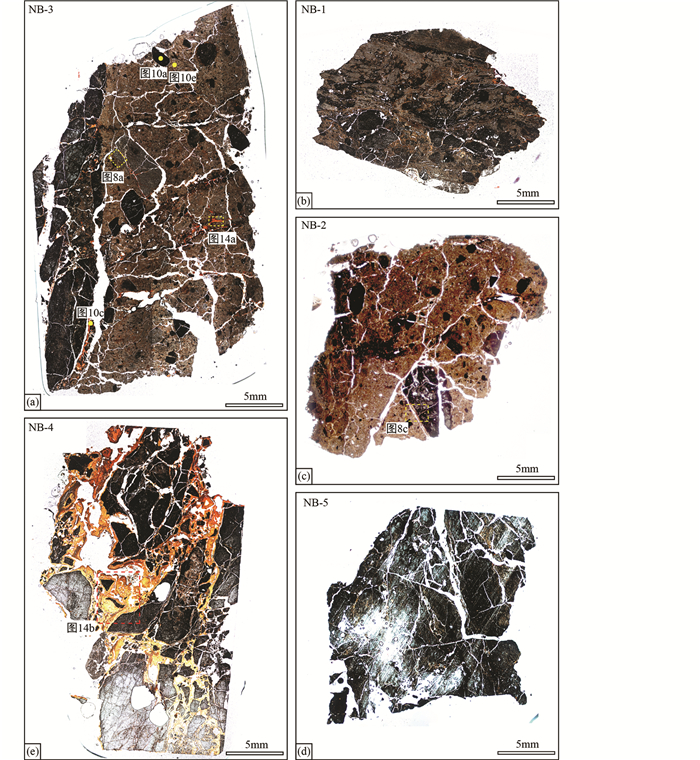
|
图 7 南坝地区黑色断裂物质薄片下的结构特征 (a)样品NB-3,主要呈块状构造,黄褐色与深黑色块体之间有着明显边界;(b)样品NB-1;(c)样品NB-2薄片照片,黄褐色块体中可见大小不一的深黑色角砾;(d)样品NB-5薄片照片,呈黑色和浅灰色;(e)样品NB-4薄片照片 Fig. 7 Thin section photos showing the features of the black fault materials in Nanba area (a) thin section photos of sample NB-3 showing the massive structure and the boundary between yellow-brown and black materials; (b) thin section photos of the sample NB-1; (c) thin section photos of the sample NB-2 showing occurrence of black breccia with various sizes in the yellow-brown material; (d) thin section photos of the NB-5 showing black and light grey materials; (e) thin section photos of the NB-4 |
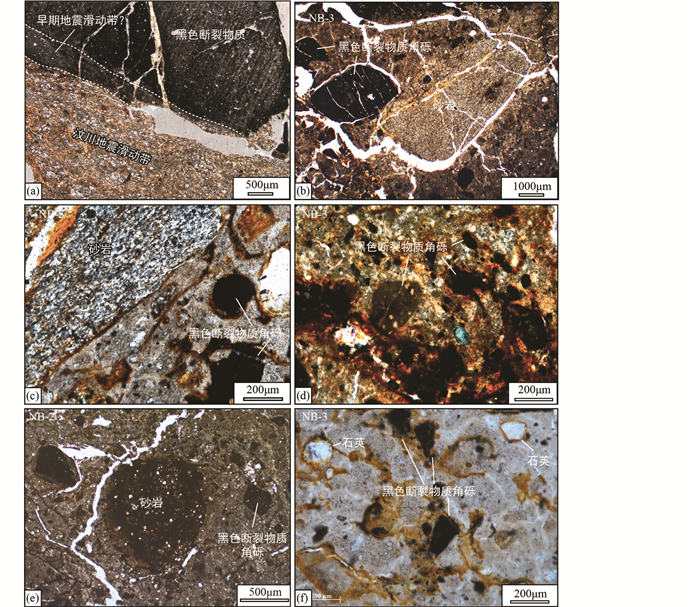
|
图 8 南坝地区黑色断裂物质单偏光下显微特征 (a)黑色断裂物质与角砾岩接触边界,可见滑动带;(b)褐色基质中间有黑色角砾,可见砂岩砾;(c)样品NB-3特征,灰褐色基质中间有少量的黑色角砾,还可见砂岩砾,棕黄色条带围绕角砾边缘生长;(d)样品NB-3特征,有残留的黑色角砾,可见绿泥石和重结晶后的矿物;(e)样品NB-2特征,灰褐色基质中有黑色角砾和砂岩砾;(f)样品NB-3特征,可见石英和残留的黑色角砾,在裂隙中可见棕黄色物质,显示流体作用特征 Fig. 8 Microstructural features of the black fault materials in Nanba area under polarized light (a) boundary between black fault material and breccia, and the co-seismic slipping zone; (b) black breccia in the brown matrix material, and the sandstone breccia; (c) sample NB-3 showing occurrence of the black breccia in the gray-brown matrix material, the sandstone breccia, and the brown-yellow stripping materials growing around the edge of the breccia; (d) residual black breccia, chlorite and recrystallized minerals in sample NB-3; (e) black breccia and sandstone clasts in the gray-brown matrix material in sample NB-2; (f) sample NB-3 showing occurrence of quartz and residual black breccia, and brown-yellow materials, indicating previous fluid action |
扫描电镜(SEM)观察显示黑色断裂物质由很多粒径大小不一(2~30μm)的石英颗粒和细小的黏土矿物组成(图 9)。其中可见水滴状、球状、环带和孔洞状构造(图 10),EDS成分分析显示其主要为含Si质成分物质(图 10g,h)。

|
图 9 南坝地区黑色断裂物质扫描电镜特征 (a)黑色断裂物质BSE图像,可见大块的石英颗粒;(b)黑色断裂物质BSE图像,可见石英颗粒和黏土矿物 Fig. 9 SEM features of the black fault materials in Nanba area (a) BSE image of the black fault material showing big-size quartz grains; (b) BSE image of black fault material showing occurrences of quartz and clay minerals |
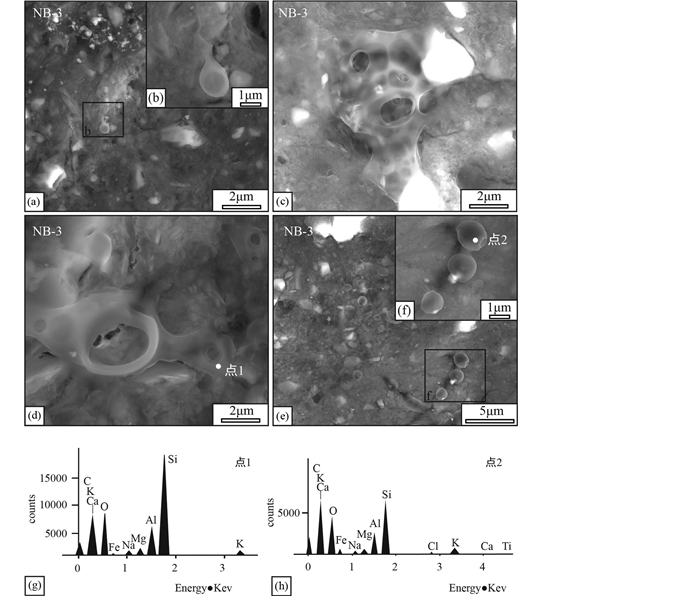
|
图 10 黑色断裂物质(样品NB-3)SEM图像及能谱曲线 (a、b)水滴状的构造;(c)似气孔构造;(d)熔融体环带构造;(e、f)球粒构造;(g)图 10d中点1的能谱图;(h)图 10f中点2的能谱图 Fig. 10 SEM images of black fault material and the SEM-EDS spectrum analysis (a, b) droplet structures; (c) vesicles; (d) melt flow structures; (e, f) spherulites; (g) the energy spectrum of point 1 in Fig. 10d; (h) the energy spectrum of point 2 in Fig. 10f |
断裂带样品的XRD图谱显示(图 11),破碎带岩石、断层角砾岩和黑色断裂物质主要矿物成分为:石英、微斜长石、斜长石以及黏土矿物,在黑色物质层中除上述矿物外,还有黄钾铁矾和重晶石等矿物。黏土矿物主要为:伊利石、绿泥石、伊蒙混层,仅两个黑色断裂物质样品中含有蒙脱石。
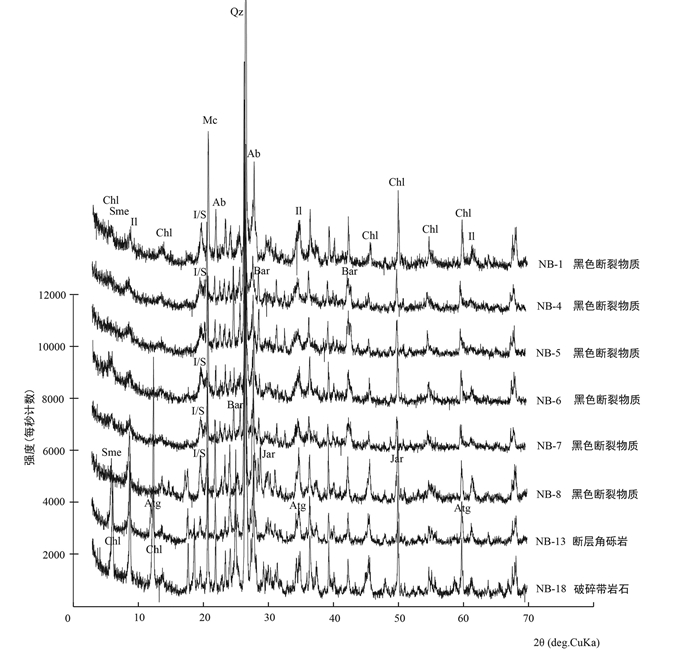
|
图 11 南坝地区北川断裂带断裂岩的XRD图谱 Qz-石英;Ab-斜长石;Mc-微斜长石;Il-伊利石;Chl-绿泥石;I/S-伊蒙混层;Bar-重晶石;Jar-黄钾铁矾;Sme-蒙脱石;Atg-蛇纹石 Fig. 11 XRD patterns of fault rocks in the Beichuan fault zone in Nanba are Qz-quartz; Ab-albite; Mc-microcline; Il-illite; Chl-clinochlore; I/S-illite/smectite; Bar-barite; Jar-jarosite; Sme-smectite; Atg-antigorite |
对20个断裂带样品进行了矿物含量的分析(表 1)。总体来看,黑色断裂物质(NB-1、NB-4、NB-5、NB-6、NB-7、NB-8、NB-9、NB-10)中石英含量31%~50%,长石含量18%~26%,黏土矿物成分含量24%~36%;断层角砾岩(NB-11、NB-13、NB-14、NB-19、NB-20、NB-21)中石英含量35%~45%,长石含量24%~36%,黏土矿物成分含量18%~34%;破碎带(NB-15~18、NB-22~24)中石英含量31%~47%,长石含量24%~45%,黏土矿物成分含量15%~45%。从破碎带到断层角砾岩再到黑色断裂物质,石英含量变化不大,但是长石含量逐渐降低,黏土矿物含量明显增加。
此外,对黑色断裂物质标本进行切割及表面抛光后,采用μXRF无损检测技术对其切面进行元素扫描。测试结果(图 12)表明,深黑色角砾的Fe、K元素含量低于棕灰色的部分,深黑色角砾中的Ba、Ti、V含量高于浅色部分的,其中黑色角砾裂隙中的Ba、Ti、V含量明显偏高。
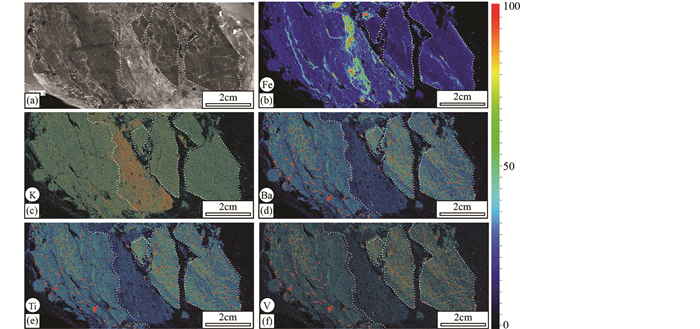
|
图 12 黑色物质样品表面μXRF测试元素分布特征 (a)黑色断裂物质扫描图;(b-f)Fe, K, Ca, Ba, Ti和V的单元素分布图,彩色条代表XRF的强度,红色区域表示高丰度,可见Ba、Ti和V之间有明显的正相关性,和K、Fe有反相关性 Fig. 12 μXRF mapping of the elements distribution of the black materials (a) scanned image of the fractured black material; (b-f) single element distribution diagrams of Fe, K, Ca, Ba, Ti and V. Color bars represent the strength of XRF. The red color indicates high abundance. There is a positive correlation between Ba, Ti and V, and a negative correlation with K and Fe |
根据变形程度的不同,断裂带可分为断层核部和破碎带。断层核部通常是作为一个滑移面或滑动带,由断裂岩(断层泥、断层角砾岩、碎裂岩或假玄武玻璃)组成,破碎带通常是由具有破裂分布较宽的围岩组成。断裂核部宽度一般较窄,小断裂可能仅有1~3mm宽,大断裂也就10~30cm宽。断裂带核部宽度虽然很窄但却容纳了断裂带的大部分变形。断裂带可分为单核结构和多核结构这两种典型类型(Faulkner et al., 2010)。单核结构为有一个高应变断层核部的断裂带(Chester and Logan, 1986),多核结构是有多个高应变断层核部的断裂带(Faulkner and Rutter, 2003)。
在研究区,北川断裂带中断裂岩和破碎带的呈规律分布,以陡倾的黑色断裂物质为中心,两侧分别为断层角砾岩和破碎带,并且它们的厚度基本一致,汶川地震滑动面沿黑色断裂物质层北西边界分布,并有~10mm的滑动带(图 3、图 5),从显微镜下观察到的滑动带则更窄。该黑色断裂物质是早期断裂滑动所产生的直接或间接物质,是断裂带的高应变带。因此,北川断裂带具有典型的单核结构特征,宽度~30m。
在映秀-北川断裂带南西段虹口地区,映秀断裂带宽约240m,由五个次级不同的断裂岩带组成:碎裂岩带(具有假玄武玻璃)、黑色断层泥和角砾岩带、灰色断层角砾岩带、深灰色断层角砾岩带以及断层泥和角砾岩带,断裂岩组合显示映秀断裂带具有多核断裂结构特征(Wang et al., 2014a),是一条从晚三叠世至现今经常发生大地震的断裂带(Zheng et al., 2016;Wang et al., 2019a)。北川断裂带与映秀断裂带具有明显不同的断裂岩组合和内部结构,反映出它们具有不同的演化历史和变形作用,是两条不同的断裂带,只是2008年汶川地震破裂使它们贯穿联通。为什么一次地震使两条不同的断裂联通?映秀断裂和北川断裂联结部位弯曲,成为典型的“拉张阶区”(图 1),根据目前的数值模拟研究,拉张阶区应力应变限制在两条主要断层间,而且容易失稳,一侧断层破裂容易跳到另一侧的控制断层上(Finzi and Langer, 2012;Wang et al., 2017, 2020),使之破裂,因此,汶川地震破裂传播过程中,破裂是由SW向NE方向传播,当破裂沿映秀断层向NE方向传播至清平拉张阶区,由于该拉张阶区容易导致应力传播,所以,破裂跳至另一条相邻的北川断裂传播。
5.2 黑色断裂物质:蚀变的假玄武玻璃从XRD分析结果(表 1、图 11)来看,研究区内的黑色断裂物质中黏土矿物含量较高(24%~36%),从SEM图像可见,黏土矿物颗粒细小呈无方向性分布,局部可见细小的伊利石围绕石英颗粒边部生长(图 9b),为后期形成的黏土矿物。以上表明黑色物质可能是断层泥,但其质地脆且易碎、为相对均质的块状结构,不同于普通断层泥呈松软状和映秀-北川断裂带南西段虹口地区具有棱角状大小不一的碎块及带状构造的断层泥(Togo et al., 2011b;Wang et al., 2014a;Wang et al., 2019a),也不同于灌县-安县断裂带中断层泥黏土矿物富集、面理发育和压溶构造的特征(He et al., 2018)。在棕灰色物质中可见大小不一、无定向的黑色物质角砾(图 7a-c),显示棕灰色物质灌入到黑色块状物质中,使它破碎的特征。综上,这些黑色断裂物质可能不是通常的断层泥。
部分黑色断裂物质(NB-6,-7)的局部XRD图谱显示,在16°~34°的低衍射角(2θ)范围具有宽的非晶质物质衍射波谱的峰带特征(图 13),在SEM图像中发现有水滴状、球状、环带和似气孔状构造的熔融结构(图 10),这些特征都明显指示了断裂核部黑色物质具有熔融形成的假玄武玻璃的特征,表明该黑色断裂物质是假玄武玻璃断层脉,是古地震的产物。

|
图 13 北川断裂带中假玄武玻璃的XRD图谱 Fig. 13 XRD patterns of pseudotachylytes in Beichuan segment |
此外,黑色物质的Fe、Ba、Ti元素含量相对较高(图 12),这与映秀-北川断裂带虹口地区出露的假玄武玻璃具有高Fe、Ba、Ti含量的特征(Wang et al., 2019b)相似。断裂带中假玄武玻璃被认为是地震发生的直接产物与证据,是古地震断层快速滑动产生高温使岩石熔融而形成的残留物,被喻为“地震化石”(Sibson et al., 1975;Lin,1994)。假玄武玻璃具有焊接断裂的作用,同时被后期的熔体灌入时也易破碎,所以在棕灰色假玄武玻璃中可见黑色假玄武玻璃角砾。北川断裂带中发育的厚层假玄武玻璃断层脉表明,该断裂带经常发生大地震活动。
显微结构观察显示,黑色物质中只发现了类似气孔和球粒构造,没有看到由于熔融而产生的明显的流动构造、不同类型微晶和不规则港湾状构造等,可能是后期蚀变作用造成熔融特征被覆盖。断裂带是流体的通道(Caine and Forster, 1999),流体-岩石相互作用可使断裂岩中的矿物发生变化。我们在显微镜下观察到了大量的流体作用的痕迹,如裂隙中生长很多黄钾铁钒等硫化物矿物,这些物质或包围黑色角砾(图 14a)或充填在灰褐色的块体的基质中(图 8c-f、图 14b)。已有的研究表明,蚀变的熔体中碎块周围往往具有明显的蚀变边缘(Wang et al., 2019a),如在石英碎块、黑色物质(假玄武玻璃)碎块和变砂岩碎块周缘可见到蚀变边缘(图 8c-e)。这些证据表明在南坝地区北川断裂带中存在地震产生的假玄武玻璃,可能由于后期流体等作用大部分已经被蚀变了。
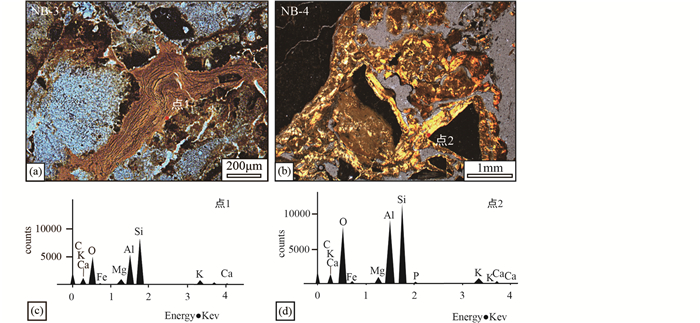
|
图 14 南坝地表露头断裂岩流体作用显微照片(a、b)及能谱曲线(c、d) (a)样品NB-3镜下特征,黄褐色的硅铝质物质分布在褐色块体中;(b)样品NB-4镜下特征,黄-黄褐色硅铝质物质将黑色块体包裹;(c)图a中点1的能谱图;(d)图b中点2的能谱图 Fig. 14 Micrographs showing fluid-rock interaction in the fault rocks (a, b) and the EDS patterns (c, d) of the analyzed spots (a) microscopic features of the sample NB-3 showing the yellow-brown salic materials developed within the brown materials; (b) microscopic features of the sample NB-4 showing yellow to yellow-brown salic materials surrounded the black fragments; (c) the energy spectrum of point 1 in the Fig 14a; (d) the energy spectrum of point 2 in the Fig. 14b |
大量的研究发现断裂带的地震滑动过程中,滑动面通常分布在断裂带底部,如映秀-北川断裂带南部虹口露头中,2018年汶川地震破裂面发育在映秀断裂带底部(Togo et al., 2011b;Wang et al., 2014a),绵竹市九龙清泉村露头和汶川科钻(WFSD-3,3P)岩心研究显示汶川地震破裂面发育在灌县-安县断裂带底部(Li et al., 2016)。1999年集集地震(Mw 7.3)的滑动面同样发育在车笼浦断裂带的底部(Yeh et al., 2007)。这些现象均表明逆冲断裂带活动,其地震破裂面(断层滑移面)往往发育在断裂带底部,这可能与逆冲断裂的生长方向有关。日本Nojima断裂带是条陡倾的右旋走滑断裂,1995年神户地震(Ms 7.2)沿该断裂发生破裂,破裂带以右旋走滑为主伴随逆冲分量,北川段断裂带性质与其非常相似。震后断裂带科学钻探和地表露头研究均揭示了神户地震滑动面发育在Nojima断裂带底部(Lin et al., 2001),然而汶川地震是沿北川段断裂带顶部破裂。为什么汶川地震破裂面发育在北川段断裂带黑色断裂物质(蚀变假玄武玻璃)层的顶部而不在底部?这是否与断裂后退式生长有关,还是其他因素控制,具体成因还需深入研究。
5.3.2 断裂滑移机制断裂滑移过程可分为速度弱化和速度强化(Dieterich,1979;Ruina,1983),速度弱化断裂快速滑动产生地震,速度强化断裂缓慢滑动(蠕滑)不产生地震。断裂岩可以提供断裂的物理、化学、应力变化等信息,是了解断裂滑移机制的重要研究对象。了解在地震过程中断裂带内发生的矿物变化、结构构造、物性特征和摩擦行为等信息,可判断在地震发生过程中的断裂弱化机制。断裂弱化机制是地震动力学研究中最关键的科学问题之一(Di Toro et al., 2011)。
我们的研究认为南坝露头中黑色断裂物质是蚀变的假玄武玻璃,其中保存有少量熔融特征,指示了断裂滑移过程中存在摩擦熔融润滑的弱化机制,表明摩擦熔融润滑是北川断裂带重要的弱化机制。目前研究认为假玄武玻璃断层脉的厚度随断层滑移量的增大而增加(Sibson,1975;Di Toro and Pennacchioni, 2005),一次大地震可以形成几毫米至几厘米厚假玄武玻璃(Di Toro and Pennacchioni, 2005)。目前我们还无法区分出20~40cm厚的黑色断裂物质层中有多少层假玄武玻璃,但可以确定的是南坝地区北川断裂带中的假玄武玻璃是经历了多期大地震事件所产生的,而且它应该是长期古地震活动的产物,并非2008年汶川地震形成的。在棕灰色假玄武玻璃中可见黑色假玄武玻璃碎块(图 7a-c、图 8b-f),说明后期断层快速滑动过程中使早期形成的假玄武玻璃破碎成为新的假玄武玻璃中的角砾。因此,我们认为北川断裂带存在多期次的快速滑动所产生的高温熔融作用,摩擦熔融润滑机制是北川断裂带滑动的重要弱化机制。
6 结论本文通过对映秀-北川断裂带北东段南坝地区地表露头调查,结合显微构造、XRD、μXRF等手段对断裂带内部岩石进行综合分析,得出以下几点结论:
(1) 北川断裂带宽度约30m,由假玄武玻璃、断裂角砾岩和破碎带组成。以含假玄武玻璃带为核部,两侧均发育厚度不等的断层角砾岩带和破碎带,构成近对称的单核断裂结构,暗示其构造演化历史与南西段虹口地区~240m宽的映秀断裂带相比较短。
(2) 北川断裂带的核部发现20~40cm厚的黑色断裂物质,经XRD和显微构造分析发现,它们是具有非晶质特征和熔融结构的假玄武玻璃断层脉,是古地震的产物。由棕灰色假玄武玻璃中分布黑色假玄武玻璃角砾的特征表明,存在多期次假玄武玻璃特征,即早期假玄武玻璃脉被后期地震滑动所破碎,并在后期出露地表的过程中受流体作用影响而发生了蚀变。
(3) 北川断裂带核部多期次假玄武玻璃断层脉的存在,不仅表明断裂带经常发生大地震活动,而且,断层摩擦熔融润滑机制是南坝地区断裂带的重要动态弱化机制。
致谢 感谢中国地质科学院地质力学所曹勇,中建材地勘中心江苏总队王雷振,陕西工程勘察研究院有限公司刘晨光,中国地质科学院地质所韩亮、李春锐和李开玉,中国地震局地球物理研究所龚正和应急管理部国家自然灾害防治研究院何祥丽等在野外和室内工作中给予的诸多帮助; 衷心感谢评审专家和本刊编辑对本文提出宝贵的建设性意见和建议,使本文质量得以提升。
Burchfiel BC, Chen ZL, Liu Y and Royden LH. 1995. Tectonics of the Longmen Shan and adjacent regions, Central China. International Geology Review, 37(8): 661-735 DOI:10.1080/00206819509465424 |
Burchfiel BC, Royden LH, van der Hilst RD, Hager BH, Chen Z, King RW, Li C, Lü J, Yao H and Kirby E. 2008. A geological and geophysical context for the Wenchuan earthquake of 12 May 2008, Sichuan, People's Republic of China. GSA Today, 18(7): 4-11 DOI:10.1130/GSATG18A.1 |
Caine JS and Forster CB. 1999. Fault zone architecture and fluid flow: Insights from field data and numerical modeling. In: Haneberg WC, Mozley PS, Moore JC and Goodwin LB (eds.). Faults and Subsurface Fluid Flow in the Shallow Crust. Washington: American Geophysical Union, 101-127
|
Chester FM and Logan JM. 1986. Implications for mechanical properties of brittle faults from observations of the Punchbowl fault zone, California. Pure and Applied Geophysics, 124(1): 79-106 |
Chester FM, Evans JP and Biegel RL. 1993. Internal structure and weakening mechanisms of the San Andreas Fault. Journal of Geophysical Research, 98(B1): 771-786 DOI:10.1029/92JB01866 |
Deng QD, Chen SF and Zhao XL. 1994. Tectonics, seismicity and dynamics of Longmenshan Mountains and its adjacent regions. Seismology and Geology, 16(4): 389-403 (in Chinese with English abstract) |
Di Toro G and Pennacchioni G. 2005. Fault plane processes and mesoscopic structure of a strong-type seismogenic fault in tonalites (Adamello batholith, Southern Alps). Tectonophysics, 402(1-4): 55-80 DOI:10.1016/j.tecto.2004.12.036 |
Di Toro G, Han R, Hirose T, De Paola N, Nielsen S, Mizoguchi K, Ferri F, Cocco M and Shimamoto T. 2011. Fault lubrication during earthquakes. Nature, 471(7339): 494-498 DOI:10.1038/nature09838 |
Dieterich JH. 1979. Modeling of rock friction: 1. Experimental results and constitutive equations. Journal of Geophysical Research, 84(B5): 2161-2168 DOI:10.1029/JB084iB05p02161 |
Faulkner DR and Rutter EH. 2003. The effect of temperature, the nature of the pore fluid, and subyield differential stress on the permeability of phyllosilicate-rich fault gouge. Journal of Geophysical Research, 108(B5): 2227 |
Faulkner DR, Mitchell TM, Rutter EH and Cembrano J. 2008. On the structure and mechanical properties of large strike-slip faults. In: Wibberley CAJ, Kurz W, Imber J, Holdsworth RE and Collettini C (eds.). The Internal Structure of Fault Zones: Implications for Mechanical and Fluid-Flow Properties. Geological Society, London, Special Publications, 299(1): 139-150
|
Faulkner DR, Jackson CAL, Lunn RJ, Schlische RW, Shipton ZK, Wibberley CAJ and Withjack MO. 2010. A review of recent developments concerning the structure, mechanics and fluid flow properties of fault zones. Journal of Structural Geology, 32(11): 1557-1575 DOI:10.1016/j.jsg.2010.06.009 |
Finzi Y and Langer S. 2012. Damage in step-overs may enable large cascading earthquakes. Geophysical Research Letters, 39(16): L16303 |
Fu BH, Shi PL and Zhang ZW. 2008a. Spatial characteristics of the surface rupture produced by the Ms 8.0 Wenchuan earthquake using high-resolution remote sensing imagery. Acta Geologica Sinica, 82(12): 1679-1687 (in Chinese with English abstract) |
Fu BH, Wang P, Kong P, Zheng GD, Wang G and Shi PL. 2008b. Preliminary study of coseismic fault gouge occurred in the slip zone of the Wenchuan Ms 8.0 earthquake and its tectonic implications. Acta Petrologica Sinica, 24(10): 2237-2243 (in Chinese with English abstract) |
Han L, Zhou YS, Chen JY, Ma SL, Yang XS, He CR and Dang JX. 2010. Structural characters of co-sesimic fault gouge in bed rocks during the Wenchuan earthquake. Quaternary Sciences, 30(4): 745-758 (in Chinese with English abstract) |
He XL, Li HB, Wang H, Zhang L, Xu ZQ and Si JL. 2018. Creeping along the Guanxian-Anxian fault of the 2008 Mw 7.9 Wenchuan earthquake in the Longmen Shan, China. Tectonics, 37(7): 2124-2141 DOI:10.1029/2017TC004820 |
Jia D, Wei GQ, Chen ZX, Li BL, Zeng Q and Yang G. 2006. Longmen Shan fold-thrust belt and its relation to the western Sichuan basin in central China: New insights from hydrocarbon exploration. AAPG Bulletin, 90(9): 1425-1447 DOI:10.1306/03230605076 |
Kirby E, Reiners PW, Krol MA, Whipple KX, Hodges KV, Farley KA, Tang WQ and Chen ZL. 2002. Late Cenozoic evolution of the eastern margin of the Tibetan Plateau: Inferences from 40Ar/39Ar and (U-Th)/He thermochronology. Tectonics, 21(1): 1001 |
Kirby E, Whipple K and Harkins N. 2008. Topography reveals seismic hazard. Nature Geoscience, 1(8): 485-487 DOI:10.1038/ngeo265 |
Li CY, Ye JQ, Xie FR, Zheng WJ, Han YP, Liu YF, Wang WT, Wei ZY, Zhao D, Ma BQ and Ren JJ. 2008. Characteristics of the surface rupture zone of the Ms 8.0 Wenchuan earthquake, China along the segment north to Beichuan. Seismology and Geology, 30(3): 683-696 (in Chinese with English abstract) |
Li HB, Fu XF, Van der Woerd J, Si JL, Wang ZX, Hou LW, Qiu ZL, Li N, Wu FY, Xu ZQ and Tapponnier P. 2008. Co-seisimic surface rupture and dextral-slip oblique thrusting of the Ms 8.0 Wenchuan earthquake. Acta Geologica Sinica, 82(12): 1623-1643 (in Chinese with English abstract) |
Li HB, Wang H, Xu ZQ, Si JL, Pei JL, Li TF, Huang Y, Song SR, Kuo LW, Sun ZM, Chevalier ML and Liu DL. 2013. Characteristics of the fault-related rocks, fault zones and the principal slip zone in the Wenchuan Earthquake Fault Scientific Drilling Project Hole-1 (WFSD-1). Tectonophysics, 584: 23-42 DOI:10.1016/j.tecto.2012.08.021 |
Li HB, Xu ZQ, Niu YX, Kong GS, Huang Y, Wang H, Si JL, Sun ZM, Pei JL, Gong Z, Chevalier ML and Liu DL. 2014. Structural and physical property characterization in the Wenchuan Earthquake Fault Scientific Drilling project-hole 1 (WFSD-1). Tectonophysics, 619-620: 86-100 DOI:10.1016/j.tecto.2013.08.022 |
Li HB, Wang H, Yang G, Xu ZQ, Li TF, Si JL, Sun ZM, Huang Y, Chevalier ML, Zhang WJ and Zhang JJ. 2016. Lithological and structural characterization of the Longmen Shan fault belt from the 3rd hole of the Wenchuan Earthquake Fault Scientific Drilling project (WFSD-3). International Journal of Earth Sciences, 105(8): 2253-2272 DOI:10.1007/s00531-015-1285-9 |
Li Y, Zhou RJ, Densmore AL, Ellis MA and Li B. 2008a. Sedimentary responses to late Cenozoic thrusting and strike-slipping of Longmen Shan along eastern margin of Tibetan Plateau. Acta Sedimentologica Sinica, 24(2): 153-164 (in Chinese with English abstract) |
Li Y, Zhou RJ, Densmore AL, Yan L, Richardson N, Dong SL, Ellis MA, Zhang Y, He YL, Chen H, Qiao BC and Ma BL. 2008b. Surface rupture and deformation of the Yingxiu-Beichuan fault by the Wenchuan earthquake. Acta Geologica Sinica, 82(12): 1688-1706 (in Chinese with English abstract) |
Li ZW, Liu SG, Chen HD, Liu S, Guo B and Tian XB. 2008. Structural segmentation and zonation and differential deformation across and along the Lomgmen thrust belt, West Sichuan, China. Journal of Chengdu University of Technology (Science & Technology Edition), 35(4): 440-454 (in Chinese with English abstract) |
Lin AM. 1994. Glassy pseudotachylyte veins from the Fuyun fault zone, northwest China. Journal of Structural Geology, 16(1): 71-83 |
Lin AM, Shimamoto T, Maruyama T, Sigetomi M, Miyata T, Takemura K, Tanaka H, Uda S and Murata A. 2001. Comparative study of cataclastic rocks from a drill core and outcrops of the Nojima Fault zone on Awaji Island, Japan. Island Arc, 10(3-4): 368-380 DOI:10.1046/j.1440-1738.2001.00335.x |
Liu J, Zhang ZH, Wen L, Sun J, Xing XC, Hu GY, Xu Q, Tapponnier P, Zeng LS, Ding L and Liu YL. 2008. The Ms 8.0 Wenchuan earthquake co-seismic rupture and its tectonic implications: An out-of-sequence thrusting event with slip partitioned on multiple faults. Acta Geologica Sinica, 82(12): 1707-1722 (in Chinese with English abstract) |
Liu J, Li HB, Zhang JJ and Zhang B. 2016. Origin and formation of carbonaceous material veins in the 2008 Wenchuan earthquake fault zone. Earth, Planets and Space, 68(1): 19 DOI:10.1186/s40623-016-0399-z |
Liu SG, 1993. The formation and evolution of Longmenshan thrust zone and western Sichuan, China. Ph. D. Dissertation. Chengdu: Chengdu University of Technology (in Chinese)
|
Liu SG, Tian XB, Li ZW, Sun W, Guo B and Liu S. 2008. Structural features of the central Longmen Mountains and the Wenchuan earthquake in Sichuan, China. Journal of Chengdu University of Technology (Science & Technology Edition), 35(4): 388-397 (in Chinese with English abstract) |
Ruina A. 1983. Slip instability and state variable friction laws. Journal of Geophysical Research, 88(B12): 10359-10370 DOI:10.1029/JB088iB12p10359 |
Scholz CH. 2002. The Mechanics of Earthquakes and Faulting. 2nd Edition. Cambridge: Cambridge University Press, 1-49
|
Shen ZK, Sun JB, Zhang PZ, Wan YG, Wang M, Bürgmann R, Zeng YH, Gan WJ, Liao H and Wang QL. 2009. Slip maxima at fault junctions and rupturing of barriers during the 2008 Wenchuan earthquake. Nature Geoscience, 2(10): 718-724 DOI:10.1038/ngeo636 |
Sibson RH, Moore JMM and Rankin AH. 1975. Seismic pumping: Ahydrothermal fluid transport mechanism. Journal of the Geological Society, 131(6): 653-659 DOI:10.1144/gsjgs.131.6.0653 |
Togo T, Shimamoto T, Ma SL and Hirose T. 2011a. High-velocity frictional behavior of Longmenshan fault gouge from Hongkou outcrop and its implications for dynamic weakening of fault during the 2008 Wenchuan earthquake. Earthquake Science, 24(3): 267-281 DOI:10.1007/s11589-011-0790-6 |
Togo T, Shimamoto T, Ma SL, Wen XZ and He HL. 2011b. Internal structure of Longmenshan fault zone at Hongkou outcrop, Sichuan, China, that caused the 2008 Wenchuan earthquake. Earthquake Science, 24(3): 249-265 DOI:10.1007/s11589-011-0789-z |
Togo T, Yao L, Ma SL and Shimamoto T. 2016. High-velocity frictional strength of Longmenshan fault gouge and its comparison with an estimate of friction from the temperature anomaly in WFSD-1 drill hole. Journal of Geophysical Research: Solid Earth, 121(7): 5328-5348 DOI:10.1002/2016JB012880 |
Wang H, Li HB, Si JL, Sun ZM and Huang Y. 2014a. Internal structure of the Wenchuan earthquake fault zone, revealed by surface outcrop and WFSD-1 drilling core investigation. Tectonophysics, 619-620: 101-114 DOI:10.1016/j.tecto.2013.08.029 |
Wang H, Li HB, Janssen C, Sun ZM and Si JL. 2015. Multiple generations of pseudotachylyte in the Wenchuan fault zone and their implications for coseismic weakening. Journal of Structural Geology, 74: 159-171 DOI:10.1016/j.jsg.2015.03.007 |
Wang H, Liu M, Ye JY, Cao JL and Jing Y. 2017. Strain partitioning and stress perturbation around stepovers and bends of strike-slip faults: Numerical results. Tectonophysics, 721: 211-226 DOI:10.1016/j.tecto.2017.10.001 |
Wang H, Li HB, Zhang L, Zheng Y, Si JL and Sun ZM. 2019a. Paleoseismic slip records and uplift of the Longmen Shan, eastern Tibetan Plateau. Tectonics, 38(1): 354-373 DOI:10.1029/2018TC005278 |
Wang H, Li HB, Si JL, Zhang L and Sun ZM. 2019b. Geochemical features of the pseudotachylytes in the Longmen Shan thrust belt, eastern Tibet. Quaternary International, 514: 173-185 DOI:10.1016/j.quaint.2018.12.030 |
Wang H, Liu M, Duan BC and Cao JL. 2020. Rupture propagation along stepovers of strike-slip faults: Effects of initial stress and fault geometry. Bulletin of the Seismological Society of America, 110(3): 1011-1024 DOI:10.1785/0120190233 |
Wang Y, Ma SL, Shimamoto T, Yao L, Chen JY, Yang Xs, He Hl, Dang JX, Hou LF and Togo T. 2014b. Internal structures and high-velocity frictional properties of Longmenshan fault zone at Shenxigou activated during the 2008 Wenchuan earthquake. Earthquake Science, 27(5): 499-528 DOI:10.1007/s11589-014-0096-6 |
Wibberley CAJ, Yielding G and Toro GD. 2008. Recent advances in the understanding of fault zone internal structure: A review. In: Wibberley CAJ, Imber J, Holdsworth RE and Collettini C (eds.). The Internal Structure of Fault Zones: Implications for Mechanical and Fluid-Flow Properties. Geological Society, London, Special Publications, 299(1): 5-33
|
Xu XW, Wen XZ, Ye JQ, Ma BQ, Chen J, Zhou RJ, He HL, Tian QJ, He YL, Wang ZC, Sun ZM, Feng XJ, Yu GH, Chen LC, Chen GH, Yu SE, Ran YK, Li XG, Li CX and An YF. 2008. The Ms 8.0 Wenchuan earthquake surface ruptures and its seismogenic structure. Seismology and Geology, 30(3): 597-629 (in Chinese with English abstract) |
Yao L, Ma SL, Shimamoto T and Togo T. 2013a. Structures and high-velocity frictional properties of the Pingxi fault zone in the Longmenshan fault system, Sichuan, China, activated during the 2008 Wenchuan earthquake. Tectonophysics, 599: 135-156 DOI:10.1016/j.tecto.2013.04.011 |
Yao L, Shimamoto T, Ma SL, Han R and Mizoguchi K. 2013b. Rapid postseismic strength recovery of Pingxi fault gouge from the Longmenshan fault system: Experiments and implications for the mechanisms of high-velocity weakening of faults. Journal of Geophysical Research, 118(8): 4547-4563 |
Yeh EC, Sone H, Nakaya T, Ian KH, Song SR, Hung JH, Lin WR, Hirono T, Wang CY, Ma KF, Soh W and Kinoshita M. 2007. Core description and characteristics of fault zones from Hole A of the Taiwan Chelungpu fault drilling project. Terrestrial, Atmospheric and Oceanic Sciences, 18(2): 327-357 DOI:10.3319/TAO.2007.18.2.327(TCDP) |
Yuan RM, Zhang BL, Xu XW and Lin CY. 2013. Microstructural features and mineralogy of clay-rich fault gouge at the northern segment of the Yingxiu-Beichuan Fault, China. Seismology and Geology, 35(4): 685-700 (in Chinese with English abstract) |
Zhang PZ, Wen XZ, Shen ZK and Chen JH. 2010. Oblique, high-angle, listric-reverse faulting and associated development of strain: The Wenchuan earthquake of May 12, 2008, Sichuan, China. Annual Review of Earth and Planetary Sciences, 38: 353-382 DOI:10.1146/annurev-earth-040809-152602 |
Zheng Y, Li HB, Sun ZM, Wang H, Zhang JJ, Li CL and Cao Y. 2016. New geochronology constraints on timing and depth of the ancient earthquakes along the Longmen Shan fault belt, eastern Tibet. Tectonics, 35(12): 2781-2806 DOI:10.1002/2016TC004210 |
邓起东, 陈社发, 赵小麟. 1994. 龙门山及其邻区的构造和地震活动及动力学. 地震地质, 16(4): 389-403. |
付碧宏, 时丕龙, 张之武. 2008a. 四川汶川Ms 8.0大地震地表破裂带的遥感影像解析. 地质学报, 82(12): 1679-1687. |
付碧宏, 王萍, 孔屏, 郑国东, 王刚, 时丕龙. 2008b. 四川汶川5.12大地震同震滑动断层泥的发现及构造意义. 岩石学报, 24(10): 2237-2243. |
韩亮, 周永胜, 陈建业, 马胜利, 杨晓松, 何昌荣, 党嘉祥. 2010. 汶川地震基岩同震断层泥结构特征. 第四纪研究, 30(4): 745-758. |
李传友, 叶建青, 谢富仁, 郑文俊, 韩用兵, 刘玉法, 王伟涛, 魏占玉, 赵冬, 马保起, 任俊杰. 2008. 汶川Ms 8.0地震地表破裂带北川以北段的基本特征. 地震地质, 30(3): 683-696. |
李海兵, 付小方, Van der Woerd J, 司家亮, 王宗秀, 侯立玮, 邱祝礼, 李宁, 吴富峣, 许志琴, Tapponnier P. 2008. 汶川地震(Ms 8.0)地表破裂及其同震右旋斜向逆冲作用. 地质学报, 82(12): 1623-1643. |
李勇, 周荣军, Densmore AL, Ellis MA, 黎兵. 2006. 青藏高原东缘龙门山晚新生代走滑挤压作用的沉积响应. 沉积学报, 24(2): 153-164. |
李勇, 周荣军, Densmore AL, 闫亮, Richardson N, 董顺利, Ellis MA, 张毅, 何玉林, 陈浩, 乔宝成, 马博琳. 2008. 映秀-北川断裂的地表破裂与变形特征. 地质学报, 82(12): 1688-1706. |
李智武, 刘树根, 陈洪德, 刘顺, 郭兵, 田小彬. 2008. 龙门山冲断带分段-分带性构造格局及其差异变形特征. 成都理工大学学报(自然科学版), 35(4): 440-454. |
刘静, 张智慧, 文力, 孙杰, 邢秀臣, 胡古月, 许强, Tapponnier P, 曾令森, 丁林, 刘延乐. 2008. 汶川8级大地震同震破裂的特殊性及构造意义——多条平行断裂同时活动的反序型逆冲地震事件. 地质学报, 82(12): 1707-1722. |
刘树根. 1993.四川龙门山冲断带与川西前陆盆地形成演化研究.博士学位论文.成都: 成都理工大学
|
刘树根, 田小彬, 李智武, 孙玮, 郭兵, 刘顺. 2008. 龙门山中段构造特征与汶川地震. 成都理工大学学报(自然科学版), 35(4): 388-397. |
徐锡伟, 闻学泽, 叶建青, 马保起, 陈杰, 周荣军, 何宏林, 田勤俭, 何玉林, 王志才, 孙昭民, 冯希杰, 于贵华, 陈立春, 陈桂华, 于慎鄂, 冉勇康, 李细光, 李陈侠, 安艳芬. 2008. 汶川Ms 8.0地震地表破裂带及其发震构造. 地震地质, 30(3): 597-629. |
袁仁茂, 张秉良, 徐锡伟, 林传勇. 2013. 汶川地震北川-映秀断裂北段断层泥显微构造和黏土矿物特征及其意义. 地震地质, 35(4): 685-700. |
 2020, Vol. 36
2020, Vol. 36


